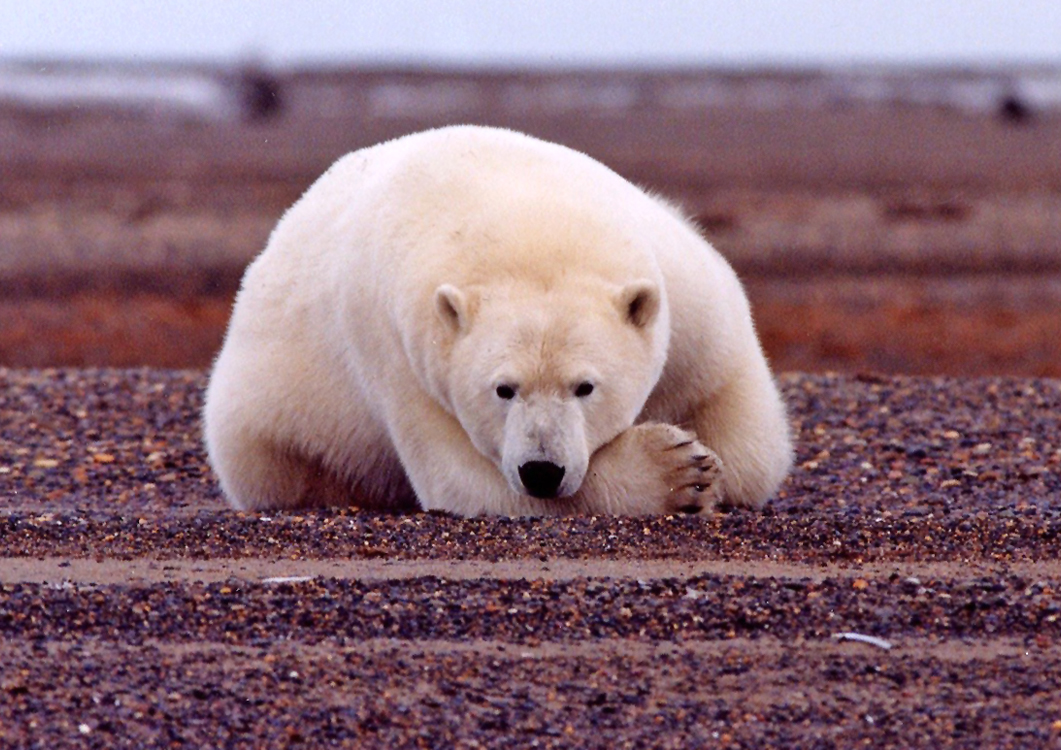
On International Polar Bear Day, a reminder that polar bears and oil drilling do not mix.
As the Arctic ice recedes, more and more polar bears are being forced to carve out a new life on the land, where they face a new set of dangers — including the potential disruption of their habitat to produce even more of the fossil fuels.

This is an updated version of a blog originally posted on our site in December 2019
The polar bear is perhaps the most iconic victim of our warming planet.
In 2015, a heartbreaking image of a starving polar bear became a global symbol of the devastating impacts of climate change. Rising ocean temperatures are gradually robbing these bears of the sea ice that provides their hunting grounds and denning habitat. As the ice recedes, more and more bears are being forced to carve out a new life on the land, where they face a new set of dangers — including the potential disruption of their habitat to produce even more of the fossil fuels that are driving climate change.
The Coastal Plain of the Arctic National Wildlife Refuge is critical habitat for polar bears — and is the subject of intense debate: to drill and extract, or preserve and protect.
The Coastal Plain has the highest concentration of onshore polar bear denning habitat in America’s Arctic. The deep snow drifts that accumulate in the shadows of its mountains provide denning sites for pregnant bears, and around 30 percent of all breeding females in the local polar bear population give birth and raise their cubs here. As a result, more than 75 percent of the area is designated as critical habitat under the Endangered Species Act.

Map of the Arctic National Wildlife Refuge. Source: Alaska Dept. of Natural Resources.
As the ice of the Southern Beaufort Sea continues to melt, forcing more and more bears onto the land, the Coastal Plain is likely to become even more critical. The polar bears that live here are already among the most vulnerable in the world. Between 2001 and 2010, their population plummeted by 40 percent, from around 1,500 to just 900. These dwindling numbers make it more important than ever that what remains of the delicate habitats in which they build their dens, reproduce and raise their young is preserved intact.
Since the Eisenhower administration, the bears that depend on these lands have been able to live and breed undisturbed, for the most part, by human activity. On Feb. 4, 2020, Sen. Ed Markey of Massachusetts and Reps. Jared Huffman of California, and Brian Fitzpatrick of Pennsylvania introduced bicameral legislation to designate the coastal plan of the Arctic National Wildlife Refuge as a wilderness area. If passed, this legislation would allow the polar bears to continue undisturbed by oil exploration.
The administration’s plan calls for the construction of airstrips and well pads, 175 miles of roads, a network of oil pipelines, a seawater-treatment plant and a barge landing and storage site on the Plain. As the Trump administration pushes through the mandatory environmental reviews, fossil fuel companies are gearing up to conduct seismic testing in the Refuge to map out the oil and gas reserves assumed to lie beneath its surface.
Polar bears give birth in mid-winter and nurture their cubs in their dens until the spring when the cubs are strong enough to venture out into the world. Human disturbances risk forcing mothers to abandon their dens before their cubs are ready for the harsh Arctic winter. The introduction of heavy machinery and other industrial infrastructure into their fragile habitat will also disrupt the corridors that the bears need in order to travel to and from the coast to hunt. It also makes it likely that bears will be killed or injured when heavy vehicles run over undetected dens.
According to Dr. Steven Amstrup of Polar Bears International, these operations pose “substantial risks of death or serious injury” to denning polar bears and their cubs, in turn impacting polar bear population levels.
Polar bears are already classed as a threatened species under the Endangered Species Act, meaning that they could soon run the risk of extinction if their habitat continues to be damaged, fragmented and destroyed. And as receding sea ice forces more bears onto the Coastal Plain, the urgency of protecting this landscape becomes far more acute.
Opening the Arctic National Wildlife Refuge to drilling is simply the wrong thing to do. This was true in the Eisenhower years, and it’s especially true in 2021, when clean renewable energy options are rapidly on the rise. We’re doing all we can to protect it.
Topics
Authors
Ellen Montgomery
Director, Public Lands Campaign, Environment America
Ellen runs campaigns to protect America's beautiful places, from local beachfronts to remote mountain peaks. Prior to her current role, Ellen worked as the organizing director for Environment America’s Climate Defenders campaign. Ellen lives in Denver, where she likes to hike in Colorado's mountains.
Find Out More

What kind of planet protector are you?

Why we should save the bees, especially the wild bees who need our help most

Why Alaska’s NPR-A, site of the Willow Project, deserves protection



